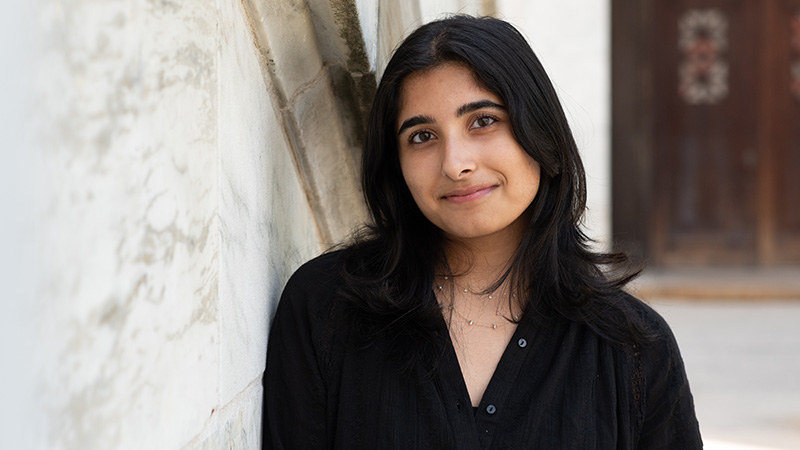Despite taking up 2% of body weight, the brain consumes 20% of the body’s energy stores at rest, and neurons have a very limited ability to store energy. When a part of the brain is active, blood vessels dilate in real time to deliver resources. Within the Gu lab, I am part of a team that studies how the brain regulates blood flow, on functional, cellular, and molecular levels. We use different imaging tools to watch this process unfold, which can ultimately give us insight into what happens when that balance is lost in diseases like stroke or dementia.
Photo by Celia Muto
What drew you to your area of neuroscience research?
I found my way into this field while tracing the paths of ions and signaling molecules in disease models of neuropathy. I was trying to understand how lithium ions might affect the nervous system, and that search brought me to a paper from the Gu Lab. I remember being struck by how carefully the work attended to both the molecular mechanisms and the broader developmental story of the blood-brain barrier. I was captivated by the idea that something as small as junctional proteins between individual cells could shape cognition, consciousness, or disease.
Now, working in the Gu lab, I find that I’m drawn to systems that require both precision and flexibility—where structure gives rise to dynamic function. Neurovascular coupling is one of those systems. Neurons and blood vessels engage in constant dialogue, and the idea that patterns of neural activity shape blood flow (on a millisecond time scale!) felt immediately and intuitively compelling. This fundamental choreography at the microscopic level reflects something larger about how the body supports the brain’s capacity to think, feel, and respond.
What is the first experiment you remember doing?
When I was eleven years old, I tested whether my classmates’ hemispheric dominance could be predicted by their performance on the Stroop effect test. The Stroop effect is a cognitive interference phenomenon where reaction time slows when the brain must process conflicting information—like reading the word “red” printed in blue ink. I hypothesized that if someone was “right-brained,” they’d be more likely to identify the color of the word before reading the word itself. I ran timed trials with each of my classmates and concluded that our class was mostly right-brained. Therefore, I informed them, we should all pursue creative paths in life to best leverage our strong right hemispheres.
I suppose there were no neuroscientists around school or home to tell me that the Stroop test isn’t a reliable tool for measuring hemispheric dominance—and that hemispheric dominance itself is largely a myth. Still, that experiment sparked a real love of scientific questioning. I went on to test the placebo effect using different sweeteners in baked goods, and the influence of electromagnetic radiation on plant growth by placing sprouts at different distances from a running microwave. These projects kept me busy until I was old enough to join a real lab, where my first experiment was a qPCR—arguably, much less exciting.
What is the trait you most admire in others?
Attentiveness. In particular, the ability to sustain meaningful attention in moments of uncertainty, and in instances where words may fall short. I admire people who listen with their full selves, who notice what others overlook, and who treat attention as a form of care. Whether directed toward a scientific project or a human interaction, there is something sacred—and vital—about that kind of presence.
What are your hopes for the future?
I hope to build a life grounded in the pursuit of understanding—not just of systems and mechanisms, but of what it means to live, to relate, and to flourish. I want to keep working at the intersection of discovery and care, where molecular mechanisms meet lived experience. I hope to continue learning from the scientists around me—whose clarity, creativity, and diligence continually teach me how to ask meaningful questions and pursue them with care. Maybe one day, I will have the privilege to become the kind of collaborator and mentor who carries forward the intellectual generosity I’ve been so fortunate to learn from. Mostly, I want to stay curious and never lose sight of the quiet moments where awe and wonder live.
What are your hobbies outside of the lab—current, past, or future?
I’ve been playing the cello since I was 5. I love being part of an orchestra and playing my instrument with others – it’s rewarding to work hard with a group and push ourselves to create something beautiful, to ultimately share it with others through performing.
I also do mixed media collage art, often focused on the intersection between scientific inquiry and abstract thought. Right now, I have a piece hanging in the Countway Library as part of the Staff Art Show. I source materials from things that would usually be discarded: junk mail, old magazines, and ephemera.
My favorite part of being a scientist is that I get to make art. And my favorite part of being an artist is that I get to do science. Each one stretches my mind in a different direction, and sometimes they unexpectedly inform each other. Lately, I’ve been playing with what it means to move between structure and spontaneity—to be intentional without being rigid, open without losing focus. Maybe one day I’ll figure out how to do both at once!
Finally, I love to interact with nature, even if it’s just paying close attention to the trees blooming on my walk to work, examining the different kinds of moss by the muddy river, or tending to the ever-growing plant family in my apartment.

